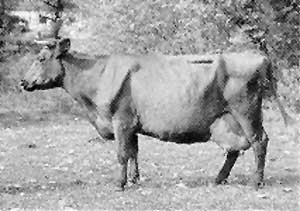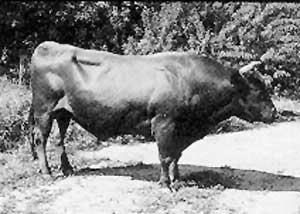Lithuanian Red Cattle
 This breed was formed early in this century by improved feeding and management of
the local Lithuanian cattle, assortative mating and mass selection and crossing with
the improved breeds: Ayrshire, Angeln, Dutch, Danish Red, Swiss Brown and Shorthorn.
The crosses were selected for milk production. Most animals are of clearly defined
dairy type. Basic measurements of the pedigree cows are as follows: withers height
126 cm, oblique body length 157 cm, chest width 43 cm, chest depth 69 cm, chest girth
188 cm, cannon bone girth 19 cm. Coat color is red. The average live weight of cows
is 470 kg; those in the herdbook weigh 520 kg and bulls 750 kg. The young stock of
the Lithuanian Red breed are noted for their rapid growth rate, good food conversion
and high carcass quality. When intensively fattened, steers weigh 413 kg as yearlings
and 503 kg Rlaen 15 months old. Up to the age of 15 months one kg of gain requires
5.32 feed units.
This breed was formed early in this century by improved feeding and management of
the local Lithuanian cattle, assortative mating and mass selection and crossing with
the improved breeds: Ayrshire, Angeln, Dutch, Danish Red, Swiss Brown and Shorthorn.
The crosses were selected for milk production. Most animals are of clearly defined
dairy type. Basic measurements of the pedigree cows are as follows: withers height
126 cm, oblique body length 157 cm, chest width 43 cm, chest depth 69 cm, chest girth
188 cm, cannon bone girth 19 cm. Coat color is red. The average live weight of cows
is 470 kg; those in the herdbook weigh 520 kg and bulls 750 kg. The young stock of
the Lithuanian Red breed are noted for their rapid growth rate, good food conversion
and high carcass quality. When intensively fattened, steers weigh 413 kg as yearlings
and 503 kg Rlaen 15 months old. Up to the age of 15 months one kg of gain requires
5.32 feed units.
The dressing percentage is 58.6 and proportion of meat 81.6%. The average daily gain of steers from 6 to 15 months of age is 1032 g. The milk yield of 83,500 mature cows was 3,362 kg with 3.69% fat; 2,700 cows at pedigree farms produced 4,337 kg with 3.87% fat. The record holders of the Red Lithuanian breed are as follows: Sloga 35 - 7th lactation, 10 754 kg milk, 4.20% fat; Zhabine 1355 - 4th, 10,242 kg, 4.33%; Gerve 1246 - 6th, 10,196 kg, 4.09%. The breed consists of 18 lines and related groups.
 The best bulls are kept at Pasval, Shaulyai and Vilnius breeding centers. The average
milk yield of the nearest female ancestors of these bulls ranges from 6,346 to 7,210
kg and the fat content is 4.39-4.72%. The Lithuanian Red breed is found in 18 districts
in the north and northeast of the Lithuanian SSR. In 1980 the total population was
567,000. Up to 10,000 head of young pedigree stock are exported annually to the Kazakh,
Uzbek and other Soviet republics. The program for the improvement of Lithuanian Red
cattle, along with pure breeding, envisages the use of Danish Red and Angeln bulls
to form high butterfat lines. Blood group analysis has shown that the tiomozygosity
rate is fairly low (6.8%). It points to a high heterogeneity of Lithuanian Red cattle
and to a great potential for improvement by accumulating the useful genes.
The best bulls are kept at Pasval, Shaulyai and Vilnius breeding centers. The average
milk yield of the nearest female ancestors of these bulls ranges from 6,346 to 7,210
kg and the fat content is 4.39-4.72%. The Lithuanian Red breed is found in 18 districts
in the north and northeast of the Lithuanian SSR. In 1980 the total population was
567,000. Up to 10,000 head of young pedigree stock are exported annually to the Kazakh,
Uzbek and other Soviet republics. The program for the improvement of Lithuanian Red
cattle, along with pure breeding, envisages the use of Danish Red and Angeln bulls
to form high butterfat lines. Blood group analysis has shown that the tiomozygosity
rate is fairly low (6.8%). It points to a high heterogeneity of Lithuanian Red cattle
and to a great potential for improvement by accumulating the useful genes.
References
Dmitriez, N.G. and Ernst, L.K. (1989) Animal Genetic Resources of the USSR. Animal Production and Health Paper Publ. by FAO, Rome, 517 pp.
